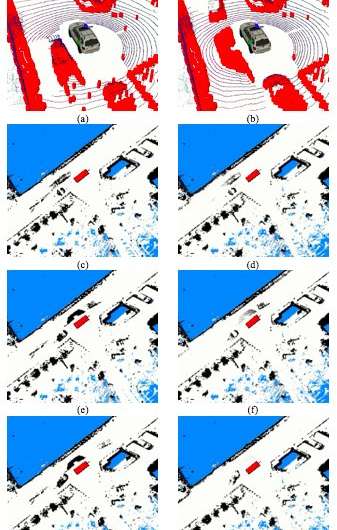October 19, 2018 feature
A new strategy to correct imperfections in occupancy grid maps

Researchers at Laboratório de Computação de Alto Desempenho (LCAD) of Universidade Federal do Espírito Santo (UFES), in Brazil, have devised a novel strategy for correcting imperfections in occupancy grid maps by correcting invalid occupancy probabilities of map cells that are unobservable by sensors. This novel technique, called map decay, is inspired by current empirical knowledge of the human brain's memory architecture.
"The long-term goal of our research team at LCAD is to understand how the human brain works," Alberto Ferreira De Souza, one of the researchers who carried out the study, told TechXplore. "It is a very ambitious goal, I know, so in order to tackle it, we did what is usual in science. That is, we envisioned to understand the brain as a series of milestones and started with the first one. In our case, it was to try and understand visual cognition, our ability to understand the world and ideas about the world using our sense of vision."
This ambitious research project started approximately 15 years ago, initially with the use of static images and then with dynamic ones taken by cameras placed on mobile robots. Later, the researchers started studying self-driving cars and eventually built their own, called IARA (Intelligent Autonomous Robotic Automobile).
"In this work, we searched for inspiration in the brain to propose improvements in existing algorithms involved in the map handling of self-driving cars," De Souza said. "The brain and its functions were analyzed from the cognitive psychology point of view; in particular, the cognitive processes related to memory in its different levels: sensory memory, short-term memory (or working memory), and long-term memory."
Humans are capable of storing information in their memory and recalling it at times of need. This fundamental ability enables the execution of physical procedures and the pursuit of long-term goals. Just as important as remembering things from the past, however, is the ability to forget irrelevant information, focusing attention on what can contribute to solving present tasks or problems.
"We analyzed the similarities between the visual-memory architecture believed to exist in the human brain and the process of building maps in self-driving cars," De Souza said. "Inspired by these similarities, we proposed a novel strategy for removing online noise from occupancy grid maps, which we called map decay."
Map decay works by merging sensory information obtained during runtime (i.e. when a system is online) with prior data from a high-precision map constructed offline. Online or offline data is emphasized according to whether map cells are observed by sensors or not.
"Cells observed by sensors are updated using traditional occupancy grid mapping techniques," De Souza explained. "Cells that are not observed are adjusted so that their occupancy probabilities tend to the values found in the offline map. The effect of this adjustment is an apparent fading, or decay, of online information in unobservable regions of the map, while high-precision offline information is retained."
The idea behind this strategy is that the most precise available information about an unobservable map cell is the value found in the high-precision offline map. UFES has applied map decay to its IARA autonomous vehicle and initial tests yielded very promising results.
"Map decay removes imperfections from online occupancy grid maps," de Souza said. "These imperfections have several causes. For example, when a dynamic object crosses the cells of a map, their occupancy probabilities are raised. Due to the self-driving-car motion, these cells may no longer be observed, leading to a trace in the map that is not erased."
Souza explained that the same issue can also occur when a false obstacle is detected, due to a natural sensor error. If cells are not observed again, whether because the robot is moving or because these cells are located within a sensorial blind spot, the occupancy probability will not be corrected.
Map decay effectively removes these imperfections, using strategies that mirror human memory processes. Just like the human brain, it releases information that is no longer necessary and makes sense of incomplete sensorial data by filling it with long-term knowledge, which is stored in the precise offline map.
"We always try and implement a state-of-the-art solution to a problem and then try and re-implement it using neural networks, our preferred paradigm for emulating the brain," De Souza said. "As future work, we will study how to implement the whole mapping process, including map decay, using deep neural networks."
More information: Map memorization and forgetting in the IARA autonomous cars. arXiv:1810.02355v1 [cs.AI]. arxiv.org/abs/1810.02355
© 2018 Tech Xplore



















